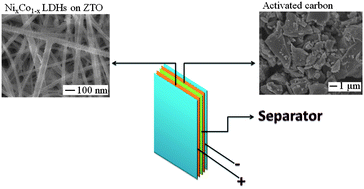Enhancing electrochemical reaction sites in nickel–cobalt layered double hydroxides on zinc tin oxide nanowires: a hybrid material for an asymmetric supercapacitor device†
Abstract
Conducting nanowires are of particular interest in energy-related research on devices such as supercapacitors, batteries, water splitting electrodes and solar cells. Their direct electrode/current collector contact and highly conductive 1D structure enable conducting nanowires to provide ultrafast charge transportation. In this paper, we report the facile synthesis of nickel cobalt layered double hydroxides (LDHs) on conducting Zn2SnO4 (ZTO) and the application of this material to a supercapacitor. This study also presents the first report of an enhancement of the active faradic reaction sites (electroactive sites) resulting from the heterostructure. This novel material demonstrates outstanding electrochemical performance with a high specific capacitance of 1805 F g−1 at 0.5 A g−1, and an excellent rate performance of 1275 F g−1 can be achieved at 100 A g−1. Furthermore, an asymmetric supercapacitor was successfully fabricated using active carbon as a negative electrode. This asymmetric device exhibits a high energy density of 23.7 W h kg−1 at a power density of 284.2 W kg−1. Meanwhile, a high power density of 5817.2 W kg−1 can be achieved at an energy density of 9.7 W h kg−1. More importantly, this device exhibits long-term cycling stability, with 92.7% capacity retention after 5000 cycles.

- This article is part of the themed collection: Nanoscale 10th Anniversary: Top Cited Articles

 Please wait while we load your content...
Please wait while we load your content...